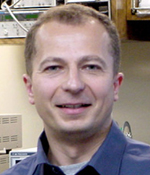Bio: Stojan Radic joins the UCSD faculty in November 2003. He received his Ph.D. in optics from The Institute of Optics (Rochester) in 1995. Radic gained a worldwide reputation while working in industry, first at Corning in the Photonics Technology division, and later at Bell Laboratories in Lightwave Systems Research (1998-03). Immediately prior to coming to the Jacobs School, Radic held a chaired position at Duke University. Radic has published 40 articles in refereed journals, and serves on committees for Optical Fiber Communication (OFC), Conference on Lasers and Electro-Optics (CLEO) and Optical Amplifiers and their Applications (OAA) conferences.
Research: Professor Radic is interested in all-optical processing schemes and their use in present and future optical communication networks. His recent research is focused on parametric processes in high confinement fiber and semiconductor devices. He is currently investigating a new class of multiple-band processing devices that will provide optical amplification, wavelength conversion and signal conjugation simultaneously. The new technology is pursued on both device and system levels, with recent record demonstrations in bandwidth, efficiency and system reach. Ongoing projects will explore the limits of parametric switching, all-optical penalty reversal and ultrafast signal processing. In addition to optical communications, this work is motivated by applications in sensing, sampling and high-power pulse generation. Radic is also actively working on bidirectional optical networking and unconventional optical signaling schemes. His recent work has demonstrated the feasibility of hybrid Raman/EDFA bidirectional links, pointing to a new direction in spectrally efficient system design. Generalized bidirectional systems are characterized by Rayleigh-dominated noise and reciprocal gain elements, and are fundamentally different from the conventional optical links. His present research includes new mitigation techniques in non-Gaussian noise environments, which are expected to lead to dramatic improvements in bidirectional system performance.
|

